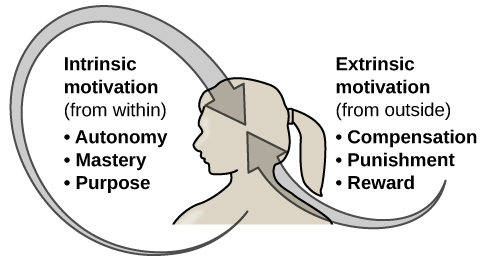Motivation
Motivation describes the wants or needs that direct behavior toward a goal. Motivations can be intrinsic (arising from internal factors) or extrinsic (arising from external factors). Intrinsically motivated behaviors are performed because of the sense of personal satisfaction that they bring, while extrinsically motivated behaviors are performed in order to receive something from others.
Think about why you are currently in college. Are you here because you enjoy learning and want to pursue an education to make yourself a more well-rounded individual? If so, then you are intrinsically motivated. However, if you are here because you want to get a college degree to make yourself more marketable for a high-paying career or to satisfy the demands of your parents, then your motivation is more extrinsic in nature. In reality, our motivations are often a mix of both intrinsic and extrinsic factors, but the nature of the mix of these factors might change over time (often in ways that seem counter-intuitive). Physical reinforcement (such as money) and verbal reinforcement (such as praise) may affect an individual in very different ways. Tangible rewards (i.e., money) tend to have more negative effects on intrinsic motivation than do intangible rewards (i.e., praise). The expectation of the extrinsic motivator by an individual is crucial: If the person expects to receive an extrinsic reward (money) then intrinsic motivation for the task tends to be reduced. If there is no such expectation (no money), and then extrinsic motivation is presented as a surprise, then intrinsic motivation (personal desire) for the task tends to persist (Deci et al., 1999).

Our thoughts, behaviors and motivations are strongly influenced by affective experiences known as drive states. These drive states motivate us to fulfill goals that are beneficial to our survival and reproduction. Drive states differ from other affective or emotional states in terms of the biological functions they accomplish. All affective states are positive or negative and serve to motivate approach or avoidance behaviors (Zajonc, 1998) but drive states are unique. Drive states generate behaviors that result in specific benefits for the body. For example, hunger directs individuals to eat foods that increase blood sugar levels in the body, while thirst causes individuals to drink fluids that increase water levels in the body. Sleep and sexual arousal are also drive states that generally function to promote our survival and reproduction.
According to the drive theory of motivation, deviations from our stable state creates physiological needs. These needs result in psychological drive states that direct behavior to meet the need and, ultimately, bring the system back to homeostasis – back to balance. For example, if it’s been a while since you ate, your blood sugar levels will drop below normal. This low blood sugar will induce a physiological need and a corresponding drive state (i.e., hunger) that will direct you to seek out and consume food. Many homeostatic mechanisms, such as blood circulation and immune responses, are automatic and nonconscious. Some may require direction action.
Different drive states have different triggers. Most drive states respond to both internal and external cues, but the combinations of internal and external cues, and the specific types of cues, differ between drives. Hunger, for example, depends on internal, visceral signals as well as sensory signals, such as the sight or smell of tasty food. Once we have engaged in a behavior that successfully reduces a drive, we are more likely to engage in that behavior whenever faced with that drive in the future (Graham & Weiner, 1996). Drive states affect many psychological processes, such as perception, attention, emotion, and motivation, and influences the behaviors that these processes generate.

